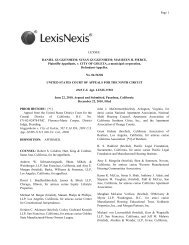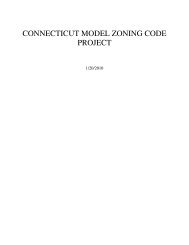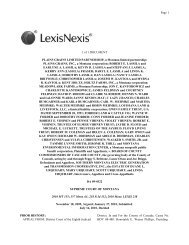Through a Glass Darkly: Measuring Loss Under ... - Land Use Law
Through a Glass Darkly: Measuring Loss Under ... - Land Use Law
Through a Glass Darkly: Measuring Loss Under ... - Land Use Law
You also want an ePaper? Increase the reach of your titles
YUMPU automatically turns print PDFs into web optimized ePapers that Google loves.
MEASURING LOSS UNDER MEASURE 37 607<br />
197.352(6). At a minimum, [he suggests] the word means something<br />
in addition to the ‘active enforcement’ of the use-restricting land use<br />
regulation.” 141<br />
In other words, were the local or state government, to require as a<br />
precondition for a Measure 37 claim, that a claimant have demonstrated<br />
active enforcement by making an application for a land use permit or<br />
the like, it would contravene subsection (7). Thus, by proving that<br />
“enforces” in subsection (1) must mean something more than merely<br />
active enforcement, Sercombe is able to establish that there is no<br />
requirement that the claim ripen in order for “compensation” to be<br />
payable. 142<br />
So far, so good. However, as the active enforcement of a land use<br />
regulation is not necessary to bring a compensation claim, 143 Sercombe<br />
goes on to submit that “it is reasonable to construe subsection 197.352(1)<br />
to base the remedy on the facial effect of a land use regulation, and not<br />
its administration.” 144 It is this with this slight-of-hand, deducing from<br />
the premise that active enforcement is not necessary in order to bring a<br />
Measure 37 claim, to the proposition that compensation should be based<br />
on the facial effect of a land use regulation only, that his analysis<br />
becomes less transparent. In fact, the argument immediately appears<br />
counterintuitive: if the claimant is able to bring a claim without demonstrating<br />
active enforcement (i.e., there is no ripeness requirement analogous<br />
to a takings claim, therefore a claim can be brought merely after<br />
passive enforcement by the local government 145 ), why does this prevent<br />
the claimant from taking into account any value-altering effects flowing<br />
from the passive enforcement of the regulation (as well as its active<br />
enactment) The presumption Sercombe appears to be making is that<br />
only enactment or/and active enforcement, and not passive enforcement,<br />
of land use regulations can have an effect on property values.<br />
Thus, without the need for active enforcement in order to bring a claim,<br />
all that is left to affect the property’s value is the facial effects of enactment.<br />
This allows Sercombe to assert that subsection 197.352(1)<br />
“hinge[s] a compensation claim upon the value reducing effects of a<br />
141. Sercombe, supra note 122, at 13.<br />
142. <strong>Under</strong> Williamson County Regional Planning Commission v. Hamilton Bank,<br />
473 U.S. 172 (1985), a taking claim must be “ripe” for adjudication. In the context of<br />
takings law, “ripeness” means that a claimant must have sought all administrative remedies<br />
before resorting to a claim for damages. Such a process is not required in order to<br />
pursue a Measure 37 claim.<br />
143. See OR. REV. STAT. § 197.352(7) (2005).<br />
144. Sercombe, supra note 122, at 13.<br />
145. See Williamson County Reg’l Planning Comm’n, 473 U.S. at 194.<br />
ABA-TUL-07-0701-Sullivan.indd 607<br />
9/18/07 10:43:45 AM







